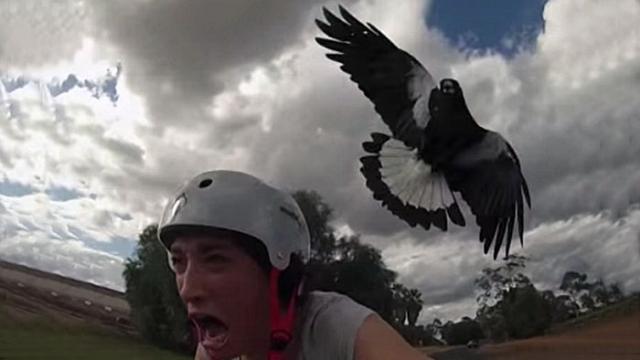September is the peak of Australia’s own version of “home-grown terrorism” (as memorably described to me by a distraught and bleeding school principal, valiantly attempting to protect his pupils), when a small but conspicuous proportion of magpies throughout the country begin to attack otherwise innocent passersby. It is certainly the most significant human-wildlife conflict in the towns and cities of this country. Here are some tips on how to survive.
Every year, many thousands of people are swooped, some are slightly injured and a few seriously (especially cyclists) — and a very small number may lose an eye.
It’s commonplace for some of us to recall the blur of wings and the click of that beak with a strange level of nostalgia, but it is sobering to appreciate that some of these attacks cause real damage and trauma. So what is going on with these otherwise favourite Aussie icons?
What’s their problem?
Explanations for this all-too familiar behaviour are legion, with passionate advocates for more plausible theories such as:
- territoriality — they are trying to keep us out of their patch
- testosterone poisoning — they are so pumped with male juice they can’t help themselves
- colour trigger — they just hate orange/yellow/purple.
While there is a lot we don’t yet know about this phenomena, all of the research conducted to date points clearly to the protective parent hypothesis.
Male magpies are adapted to drive away potential predators, and are especially when the chicks are vulnerable nestlings. For some reason, certain males (around 10 per cent of breeding pairs) have come to view humans as serious threats to their chicks and act according.
While these avian assessments seems to be false (most victims are unlikely to have eaten a baby magpie!), the resulting swoops and attacks seem to be an attempt to drive intruders away from the nest tree.
Furthermore, when we flee from the onslaught, the bird’s main objective — moving a dangerous predator on — is successful and the behaviour rewarded.
Having proved to himself his proficiency at the task means he is all the more likely to try again next time. And when especially dim-witted humans — by continuing toward the nest — don’t seem to get the hint, the intensity of the message can become more and more pronounced.
One of the numerous unexpected findings of research I’ve been a part of was the extent to which those magpies that are aggressive specialise on particular groups of people. For example, in a Brisbane study, the birds targeted either pedestrians only (about 50 per cent), posties only (10 per cent) or cyclists only (10 per cent) with remarkably few being less catholic in their preferences.
Of course, some were entirely non-discriminating and maniacally swooped any vaguely human intruder regardless of mode of transport.
Thankfully these extreme birds are relatively rare but account for the majority of the seriously dangerous. Typically, we found that such birds were almost always associated with locations with a lot of people: schoolyards, car parks, or busy park lands.
Perhaps most surprisingly, a clear majority of pedestrian-specialists actually targeted a very small number of specific individuals, typically just one or two people. If you think that these bloody birds are picking on you specifically, you are probably right!
Given that most adult magpies, once they settle down with a mate, almost never leave their territory, it is highly likely that they know and recognise all the people that they share this space with (an ability well established among close relatives).
How can we discourage attacks?
Being so common and virtually ubiquitous in Australia, this phenomenon has lead to the development of lots of counter-measures including:
- the traditional eyes on the back of the hat (or ice cream container)
- the waving of a stick
- festooning ones bike helmet with a forest of spikes or rear-facing eyes, as demonstrated (unsuccessfully!) in the video below.
Such tactics can be roughly placed into one of three categories:
- attempts to change the magpies’ behaviour
- protection of the head
- avoiding the “attack zone”.
The success of these categories can be equally roughly evaluated as “futile”, “well worth trying” and “sensibly obvious”, respectively.
Starting with the clearest approach, knowing that most magpies limit their attacks to an area surrounding the nest tree (though some cyclist-specialists can carry on for quite away), simply avoiding known hot-spots is certainly the best bet.
The old eyes-facing-backwards scheme is actually based on a sound behavioural concept: most magpies do attack from behind and are unlikely to do so if they think that they are being watched.
Unfortunately, most of our attempts to test this traditional approach failed; the birds appeared not to notice the eyes, or attacked from the side instead.
Likewise, the sharp-looking helmet protrudences are a hopeful deterrent to the oncoming bird, suggesting an uncomfortable outcome should contact be made. Otherwise, any method that may negate contact with the head is worth trying: sticks, hats, helmets and umbrellas.
Finally, an unconventional — and controversial — approach should be mentioned, simply because, in the right circumstances, it really does work.
Where it is possible for an aggressive magpie to know people as individuals, providing small food snacks (cat food) in an obvious way such that the bird can associate the treats with the person often lead to complete cessation of hostilities.
Yes, I know that such behaviour will lead directly to disease, dependence and end of civilisation, but sometimes pragmatism wins. Have a safe spring.
Darryl Jones is Deputy Director of the Environmental Futures Centre at Griffith University. He receives funding from Brisbane City Council, the Queensland State Government and the Australian Research Council.
This article was originally published at The Conversation, and has been revised and updated since its original publication date.

Leave a Reply
You must be logged in to post a comment.